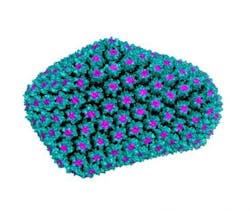Microscopy techniques demonstrate how HIV is protected from immune system
Using a single-molecule microscopy technique, researchers at the University of New South Wales (UNSW; Sydney, Australia) and colleagues in the UK have discovered that the human immunodeficiency virus (HIV) invades a small molecule from the host cell to protect itself from being destroyed by the host's immune system. Doing so, they identified a target for antiviral therapy against HIV, and provided a method for testing and measuring new drugs designed to target the capsid (protein shell).
Related: Spectroscopy method clarifies molecular process of anti-HIV drug
HIV forms a capsid to shield its genetic material from host defense mechanisms as it enters the cell and makes its way to the nucleus to establish infection. With the single-molecule microscopy technique developed at UNSW's Single Molecule Science in the Faculty of Medicine, the research teams found that HIV specifically incorporates a small molecule from the host cell—inositol hexakisphosphate—to strengthen its capsid. The host inadvertently provides the key for the virus infecting it to lock down the protective shell, keeping the genetic cargo safe until it is released into the nucleus.
"The HIV capsid falls apart within minutes once it's isolated from the virus," says associate professor Till Böcking, who led the UNSW team. "Our strategy lets us study exactly how a native capsid breaks apart in real-time without taking it out of the viral membrane."
With the help of associate professor Stuart Turville of the Kirby Institute (Darlinghurst, NSW, Australia), the research team engineered viruses with fluorescent tags to monitor the viral capsid using fluorescence microscopy. This allowed them to see the effect of different molecules on the capsid, and pinpoint precisely when it cracks open and begins to collapse, Böcking says.
The researchers found that inositol hexakisphosphate, which is abundantly present inside mammalian cells, makes the capsid much stronger, stabilizing it for 10–20 hours.
"The HIV capsid has been intensively studied, but the question of how it can simultaneously be both stable and poised to 'uncoat' has been one of the great unanswered questions in HIV biology," says Leo James, leader of the research team at the Medical Research Council Laboratory of Molecular Biology (Cambridge, England).
Most of the currently approved HIV therapies target enzymes needed at different stages of the virus' life cycle, but none of them are directed at the HIV capsid. New drug alternatives could improve the treatment of HIV with reduced toxic effects.
Full details of the work appear in two papers in the journal eLife: doi.org/10.7554/elife.35335 and doi.org/10.7554/elife.34772.
